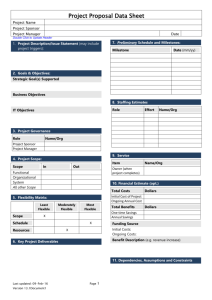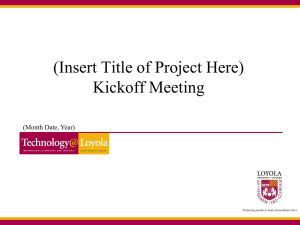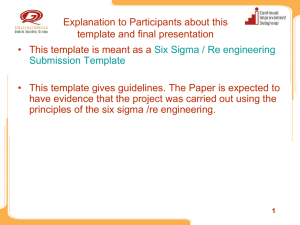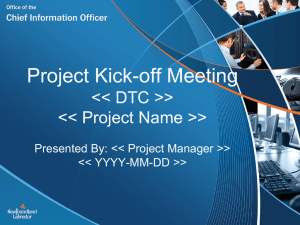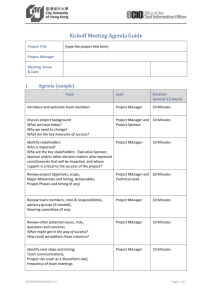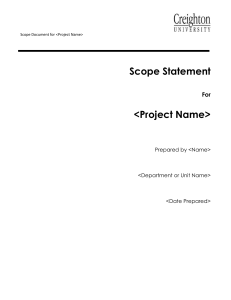Scope Statement Instructions
advertisement
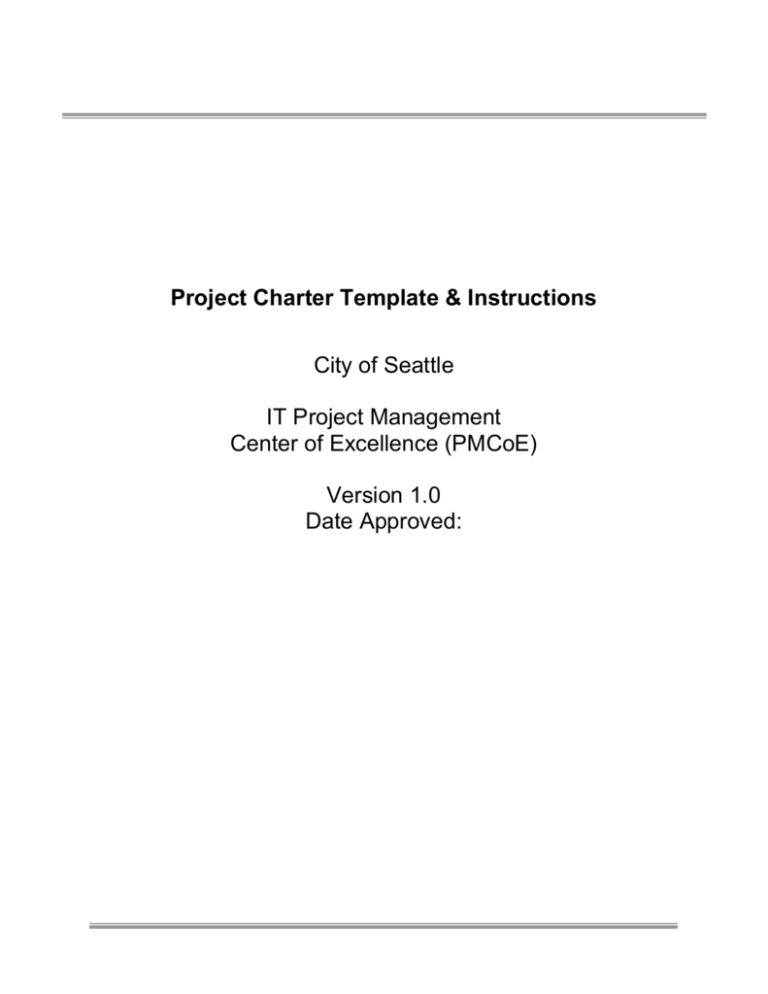
Project Charter Template & Instructions City of Seattle IT Project Management Center of Excellence (PMCoE) Version 1.0 Date Approved: City of Seattle, IT PMCoE [XXX] Project Charter Approval Approval of this Project Charter authorizes the overall project and approves spending for completing the Planning Stage of this project. The plan for completing the Planning Stage is included in Section 7 of this document. Date Project Owner <Name> Project Sponsor <Name> Project Steering Committee <Name> Project Steering Committee <Name> Project Steering Committee <Name> Project Manager <Name> Date Date Date Date Date Revision History Date By Action Pages Page i Project Charter Template & Instructions v. 1.0 12/03/2004 IT Project Management Center of Excellence City of Seattle, IT PMCoE Table of Contents [XXX] PROJECT CHARTER APPROVAL ............................................................................................................ I REVISION HISTORY ...................................................................................................................................................... I TABLE OF CONTENTS ...........................................................................................................................................II 1. EXECUTIVE SUMMARY .................................................................................................................................1 2. BUSINESS OBJECTIVES ..................................................................................................................................1 A. B. C. 3. BUSINESS NEED OR OPPORTUNITY .................................................................................................................1 OBJECTIVES ....................................................................................................................................................1 PRODUCT DESCRIPTION (SOLUTION) ..............................................................................................................2 PROJECT DESCRIPTION ................................................................................................................................3 A. B. C. D. E. F. G. H. I. 4. SCOPE .............................................................................................................................................................3 DELIVERABLES AND COMPLETION CRITERIA ..................................................................................................3 RISK ASSESSMENT ..........................................................................................................................................4 CONSTRAINTS .................................................................................................................................................5 ASSUMPTIONS .................................................................................................................................................5 DEPENDENCY LINKAGES ................................................................................................................................5 IMPACTS .........................................................................................................................................................5 MEASURES OF PROJECT SUCCESS ...................................................................................................................5 PROJECT ORGANIZATION, ROLES, RESPONSIBILITIES, AND AUTHORIZATIONS .....................................................7 PROJECT APPROACH ...................................................................................................................................10 A. 5. PLANNED APPROACH ....................................................................................................................................10 PROJECT ESTIMATES ..................................................................................................................................11 A. B. C. D. E. 6. ESTIMATED SCHEDULE .................................................................................................................................11 RESOURCE REQUIREMENTS – TEAM AND SUPPORT RESOURCES...................................................................11 ESTIMATED COST .........................................................................................................................................12 FUNDING SOURCE(S) ....................................................................................................................................12 CHECKPOINT/ FUNDING SCHEDULE ..............................................................................................................12 PROJECT CONTROLS ...................................................................................................................................14 A. B. C. D. E. F. G. H. 7. COMMUNICATION MANAGEMENT .................................................................................................................14 ISSUE MANAGEMENT ....................................................................................................................................14 CHANGE MANAGEMENT ............................................................................................................................... 14 BUDGET MANAGEMENT ............................................................................................................................... 15 SCHEDULE MANAGEMENT ............................................................................................................................15 PROCUREMENT MANAGEMENT.....................................................................................................................16 QUALITY MANAGEMENT ..............................................................................................................................16 PROJECT SHUTDOWN CONDITIONS ...............................................................................................................16 PLAN FOR COMPLETING THE PROJECT PLANNING STAGE ...........................................................17 A. B. C. D. PLANNING STAGE DELIVERABLES.................................................................................................................17 PLANNING STAGE SCHEDULE ESTIMATE .......................................................................................................17 PLANNING STAGE COST ESTIMATE ...............................................................................................................18 PLANNING STAGE RESOURCE REQUIREMENTS ..............................................................................................18 Page ii Project Charter Template & Instructions v. 1.0 12/03/2004 IT Project Management Center of Excellence City of Seattle, IT PMCoE 1. Executive Summary <Provide a brief summary of the project using the Business Case as a basis for this text.> 2. Business Objectives A. Business Need or Opportunity <The discussion of the need/opportunity should be stated in business terms and should provide an understanding of: What created the need, or how the opportunity was recognized What is the overall strategic alignment? Factors to consider include mayoral initiatives and priorities and the department’s strategic plan. The magnitude of the need/opportunity Contributing factors, such as workload increases or staff reductions, and fiscal constraints An understanding of the extent to which the need/opportunity would be addressed if an appropriate alternative were implemented The consequences for the Department and its customers if the need or opportunity is not addressed.> <By understanding the magnitude of the need or opportunity, the Department will be better able to estimate reasonable amounts of resources to expend in responding to it, and the extent to which a response will resolve it.> <Use the Business Case as a basis for this text.> B. Objectives <The project’s objectives should be written by, or based on an interview with the Project Sponsor. What objectives will need to be met for this project to be successful? Objectives should be S.M.A.R.T.: specific, measurable, accurate, realistic, and time bound. For example: “Within one year of go-live, 98% of services invoices will be correctly processed within 2 business days of receipt”. Both the business and technical objectives related to scope, schedule, budget, business impact/benefits and customer satisfaction should be considered.> <Objectives are given a tracking ID to facilitate traceability to scope, requirements, and final acceptance.> Objective Tracking ID# Project Objectives O-1 O-2 O-3 O-4 O-5 Page 1 Project Charter Template & Instructions v. 1.0 12/03/2004 IT Project Management Center of Excellence City of Seattle, IT PMCoE C. Product Description (Solution) <Describe the proposed solution and state how it meets the business need/opportunity and objectives. Typically, a Product Description Statement does not have a great deal of detail at this point.> Page 2 Project Charter Template & Instructions v. 1.0 12/03/2004 IT Project Management Center of Excellence City of Seattle, IT PMCoE 3. Project Description A. Scope <Describes the current view of the boundaries of the proposed project including what is included and what is excluded. Some specific areas to consider would include the scope related to organizational processes, business processes, and other systems. Scope includes all products and services to be provided by the project; the scope elements listed here would be equivalent to the items represented at the deliverables level of a detailed work breakdown structure. Carry over any relevant content from the Business Case.> <Ensure traceability to the project’s objectives> In Scope The Scope, as defined in this Project Charter, represents the current view of what the project will and will not deliver. After this Charter is approved, any changes or additions to scope as described below will be subject to the change management process and approval by the Project Sponsor. In Scope Scope Tracking ID# Scope Element Description Addresses Objectives(s) IS-1 IS-2 IS-3 IS-4 IS-5 Out of Scope These components are out of the scope of the project. They may be included in the scope of future enhancements or other projects. Out of Scope Scope Tracking ID# Scope Element Description OOS-1 OOS-2 OOS-3 OOS-4 OOS-5 B. Deliverables and Completion Criteria <What will be created in terms of deliverables (and their characteristics) and/or what constitutes successful completion.> <Deliverables are tangible products or things that the project will produce, stated at a high level. They describe what the business clients will get when the project is done. It is important to also state Page 3 Project Charter Template & Instructions v. 1.0 12/03/2004 IT Project Management Center of Excellence City of Seattle, IT PMCoE exclusions, or what will not be included in the project. Deliverables will be more detailed in the project plan.> <Examples: Deliverables included: A product A new service Recommendations on new automation A feasibility study A new voice response system> <Ensure traceability to the project scope elements> The following is a draft list of the deliverables to be produced by this project. Deliverable Name Description & Completion Criteria Addresses Scope Element(s) C. Risk Assessment <Describe the most significant project risks and a high-level mitigation strategy for each risk. At this point major risks should be identified, quantified and periodically reviewed with the project owner. This brief assessment will be expanded in the formal Risk Management Plan, which will be completed as part of the Project Plan.> The overall risk rating for this project is: High, Medium, Low <Select one>. <The top risk items for this project are as follows: (EXAMPLES ONLY) 1. Getting acceptance of the project objectives and required support by the key executive stakeholders. Mitigation Strategy: Meet with each of the executive stakeholders and provide an executive overview of the project objectives and approach. Follow-up with key stakeholders to validate interim results and get buy-in. 2. The high level of business process redesign will require significant organizational and cultural change. Mitigation Strategy: Business executives will drive the business process redesign using a Page 4 Project Charter Template & Instructions v. 1.0 12/03/2004 IT Project Management Center of Excellence City of Seattle, IT PMCoE highly inclusive approach to involve and educate users on what will change, why it will change, how it will change. 3. Limited time/availability from the stakeholders could limit the information available to define the scenarios for the prototype demonstrations. Mitigation Strategy: 4. The technology advances may obsolete the solution before the project is implemented Mitigation Strategy: > D. Constraints <All projects have known limitations, and such constraints need to be defined from the outset. Projects have resource limits in terms of people, money, time, and equipment.> <Examples: Project funding streams limit project expenses to no more than $250K per fiscal quarter. All technology solutions must comply with existing technology and architecture standards. No contract services may be used on the project. Purchased software must be implemented with no customization. E. Assumptions <Assumptions are circumstances and events that need to occur for the project to be successful, but may be outside the control of the project team. Identifying project assumptions helps establish the project environment and provides a basis for planning and estimating. Establishing assumptions can also test to ensure that project stakeholders share a common understanding of the project and each clearly understands their own obligations. Examples: “The project will be 50% funded by Department A and 50% funded by Department B.” “Support and attention will be provided by the Business Sponsor and the Steering Committee”. “Resources will be available to adequately staff the project”.> F. Dependency Linkages < In some cases, one project may be dependent upon another project’s deliverables; this linkage needs to be identified and its progress monitored. In other cases, a project may be dependent upon information from several departments; here, the tasks and activities of the information gathering process need to be monitored.> G. Impacts <For example, Organizational/Cultural Change, Business Process and/or Business Rule Changes, Re-training, Increases/Decreases in operating budgets, etc.> H. Measures of Project Success <This section describes the metrics that will be used to determine how success will be measured. Such metrics might include how to measure customer satisfaction, or might state what a “user friendly” system is. Solicit input from the Project Sponsor. Success criteria are expressed as statements of the business value that must be achieved for the project to be considered successful. Critical objectives of the project should be selectively reiterated here to provide additional emphasis. The best success criteria to include are those objectives that clearly state the bottom-line impact of the project. Success criteria that address project scope, budget and schedule should also be included.> Page 5 Project Charter Template & Instructions v. 1.0 12/03/2004 IT Project Management Center of Excellence City of Seattle, IT PMCoE Examples: The project delivers all baseline scope elements, as specified by this Charter.* The project completes within [XX]% of baseline budget, as specified by this Charter. The project is completes within [XX] weeks of its baseline completion date as specified by this Charter. The Success Criteria (1) (What the project sponsor wants) 1. Time (end date) 2. Resources (Total $ or Hours) 3. Scope (Capabilities, Functions) 4. Quality 5. Stakeholder Satisfaction 6. Team Satisfaction How success will be measured Estimates and / or major risks to achieving the metric. (What the PM estimates it will take) (Must Meet, Acceptable, Date: or Optimize) (Must Meet, Acceptable, $ or Optimize) (Must Meet, Acceptable, See Scope Section or Optimize) (Must Meet, Acceptable, See Scope Section or Optimize) (Stakeholders’ critical project objectives are met, but they do not have to love the project) (Project team and other stakeholders must rate their experience in working on this project at least (n) on a scale of 10.) 7. ROI Note 1): The can be only one “Must-Meet” and one “Optimize” condition. All the rest are to meet an “Acceptable” measure of success. Page 6 Project Charter Template & Instructions v. 1.0 12/03/2004 IT Project Management Center of Excellence City of Seattle, IT PMCoE I. Project Organization, Roles, Responsibilities, and Authorizations Sponsorship and Governance <Insert Project Organizational chart, consider including relationships beyond the project team such as internal and external key stakeholders. Org Chart is required for large project, optional for small/medium project.> Roles and Responsibilities <Resource table below must include named Project Sponsor for Charter approval. If known, names of other planned resources should also be included.> The following role definitions are being applied to the resources assigned to this project: <EXAMPLES ONLY – Revise as appropriate for the project> Project Responsibilities Named Resource or Role [XXX],Project Owner [XXX],Project Sponsor Steering Committee [XXX],Project Manager SME (Subject Matter Experts)/ Business Experts / User Support Analyst Provides policy definition to the Project team Resolves all policy issues with the appropriate policy owners in order to provide a clear, decisive definition Makes final decisions and resolves conflicts or issues regarding project expectations across organizational and functional areas. Provides executive team approval and sponsorship for the project. Recipient and final approver of project deliverables. Secure project funding Provide project guidance and strategic direction Act as final authority on escalated issues Act as final authority on decisions related to the project scope, schedule and budget Selects Project Manager Provide project guidance and strategic direction Resolve escalated issues as appropriate Review and preliminarily approve project deliverables as appropriate Monitor project progress and provide necessary tools and support when milestones are in jeopardy Manage project team, scope, budget, schedule and deliverables Monitor project progress, generate status reports Communicate with stakeholders Resolve and escalate issues Ensure completion and approval of project deliverables Facilitate change control, risk management, other controls as specified by this Charter Represent business area in defining, reviewing, and approval of deliverables Contribute expertise and knowledge as appropriate Analyze, design and ultimately improve or replace the business processes Collaborates with teams to develop high level process designs and models, understanding best practices for business processes Page 7 Project Charter Template & Instructions v. 1.0 12/03/2004 IT Project Management Center of Excellence City of Seattle, IT PMCoE Project Responsibilities Named Resource or Role Stakeholder Project Team [Other resource, if applicable] Provides requirements Recipient of project deliverable and associated benefits Participate in approach planning, task estimation Complete project deliverables as assigned Authorizations <Define the role that will approve each of the key deliverables through the Project Planning Stage.> <The Charter will be approved by: The Project Manager The Project Owner The Project Sponsor The Project Plan will be approved by: The Project Manager The Project Owner The Project Sponsor Project Changes will be approved by: The Project Owner Project deliverables will be approved/accepted by: The Project Owner The Project Sponsor The key Stakeholders Specific task responsibilities of project resources will be defined in the Project Plan.> Page 8 Project Charter Template & Instructions v. 1.0 12/03/2004 IT Project Management Center of Excellence City of Seattle, IT PMCoE Stakeholders Department/ Area Name, Title Role Project Sponsor Project Owner Project Manager Steering Committee Member Steering Committee Member Steering Committee Member Steering Committee Member Steering Committee Member Steering Committee Member Steering Committee Member Page 9 Project Charter Template & Instructions v. 1.0 12/03/2004 IT Project Management Center of Excellence City of Seattle, IT PMCoE 4. Project Approach A. Planned Approach <Describe how the project will be implemented. For example, discuss SDLC methodology; plans for a pilot or phased implementation; outsourcing plans, or the hiring of temporary resources; procurement plans; buy or build strategy; creation of various testing environments, etc.> Page 10 Project Charter Template & Instructions v. 1.0 12/03/2004 IT Project Management Center of Excellence City of Seattle, IT PMCoE 5. Project Estimates A. Estimated Schedule <Define the target start and end dates appropriate for your project, and define a confidence level consistent with the current level of uncertainty and risk for the project > The project will begin on [xx/xx/xx] and is estimated to be completed by [xx/xx/xx]. Confidence levels in the schedule estimates for the total project are [+xx%-%xx]. Key project milestones relative to project start are as follows: <Define the Milestones and Target Dates appropriate for your project.> Project Milestones Target Date Project Started MM/DD/YYYY Project Completion MM/DD/YYYY Schedule Assumptions <List all assumptions on which the schedule estimate is based and will be needed to reproduce or recalibrate the schedule estimate. > B. Resource Requirements – Team and Support Resources The following personnel resources are required to complete this project: <EXAMPLE ONLY – Revise as appropriate for the project> Personnel Resource Types: Quantity <Project Sponsor 1 Project Owner 1 Steering Committee 6 Stakeholders 12 Project Manager 1 Architect 1 Analysts 6 Vendor Personnel 4 Total Personnel Resources: 32> Page 11 Project Charter Template & Instructions v. 1.0 12/03/2004 IT Project Management Center of Excellence City of Seattle, IT PMCoE Resource Assumptions <List any assumptions used to create the resource requirements.> C. Estimated Cost <EXAMPLE ONLY – Revise as appropriate for the project> Project Year 1 Project Year 2 Project Year 3 Total Project Annual PostImplementation Operations & Maintenance Labor Internal IT Internal Business External $ $ $ $ $ $ $ $ $ $ $ $ $ $ $ $ Hardware Software Other $ $ $ $ $ $ $ $ $ $ $ $ Total (cost to production) $ $ $ $ Cost Estimate Assumptions <List all assumptions on which the cost estimate is based and that will be needed to reproduce or recalibrate the cost estimate.> D. Funding Source(s) <[XXX] department(s), division(s), etc.] have allocated $[XXX] towards the completion of the [XXX] project. Carry over any relevant content from the Business Case.> <EXAMPLE ONLY – Revise as appropriate for the project> Funding Source Project Year 1 Project Year 2 Project Year 3 Total Project Annual PostImplementation Operations & Maintenance Source # 1 Source # 2 Source # 3 $ $ $ $ $ $ $ $ $ $ $ $ Total Funding $ $ $ $ E. Checkpoint/ Funding Schedule Page 12 Project Charter Template & Instructions v. 1.0 12/03/2004 IT Project Management Center of Excellence City of Seattle, IT PMCoE <It is recommended that the project identify project checkpoints or phase review gates based on specific project events, for example, end of business assessment phase, or some System Development Life Cycle phases, etc. Dates are not needed here, but these checkpoints should be clearly visible in the project milestones listed earlier.> <End of Phase I Planning End of Phase I Development End of Phase I Implementation End of Phase II Planning Etc.> Page 13 Project Charter Template & Instructions v. 1.0 12/03/2004 IT Project Management Center of Excellence City of Seattle, IT PMCoE 6. Project Controls A. Communication Management The Project Manager will actively manage project communications. Project communications are to include the following meetings and status reporting. A detailed communications plan will be included in the project plan. <The following strategies have been established to promote effective communication within and about this project: The Project Manager presents the project status to the project owners on a weekly basis; however, ad hoc meetings will be established at the project manager’s discretion as issues or change control items arise. The project manager provides a written status report to the project owners on a monthly basis and distributes the project team meeting minutes. The project owners will be notified via email on all urgent issues. Issue notification will include time constraints, and impacts, which will identify the urgency of the request for service. The project team will have weekly update/status meetings to review completed tasks and determine current work priorities. Minutes will be produced from all meetings. The project manager will provide the project sponsors with project team minutes and steering committee status reports. The project steering committee will have bi-weekly meetings to project progress, confirm project direction, establish priorities, and approve project deliverables. Minutes will be produced from all meetings. A project web site will be established on the InWeb to provide access to the project documentation by geographically dispersed project members. > B. Issue Management <Project-related issues will be tracked, prioritized, assigned, resolved, and communicated in accordance with the Project Management Procedures: Issue descriptions, owners, resolution and status will be maintained on an issues database in a standard format. Issues will be addressed with the project owner and communicated in the project status report.> C. Change Management <The change control procedures to be followed will be consistent with Project Management Procedures and consist of the following processes: A Change Control database will be established by the project manager to track all changes associated with the project effort. All Change Requests will be assessed to determine possible alternatives and costs. Change Requests will be reviewed and approved by the project owner. The effects of approved Change Requests on the scope, schedule, and budget of the project will be reflected in updates to the project plan. Page 14 Project Charter Template & Instructions v. 1.0 12/03/2004 IT Project Management Center of Excellence City of Seattle, IT PMCoE The Change Control database will be updated to reflect current status of Change Requests. > D. Budget Management < The Project Manager will measure and report actual cost to planned cost on a bi-weekly basis. When actual costs exceed planned costs for the work produced the corrective actions will be approved as follows: If actual costs are found to exceed planned cost for the current reporting period: [-X]% overage is reported to Project Sponsor (and Steering Committee, if applicable), who will approve proposed corrective actions or other mitigating decisions. If actual cost is found to exceed budgeted cost/schedule for the overall project to date: [-X]% overage is reported to Project Sponsor (and Steering Committee, if applicable), who will approve proposed corrective actions or other mitigating decisions.. Corrective actions and mitigating decisions may include any or a combination of the following: Improving development/implementation processes Improving skills proficiencies Reducing or eliminating baseline scope elements Increasing the project budget Lengthening the project schedule Canceling the project (decided by the Project Sponsor or by the Project Sponsor in consensus with the Steering Committee). Also see Project Shutdown Conditions Etc..> E. Schedule Management < The Project Manager will measure and report actual schedule performance to planned schedule performance on a bi-weekly basis. When actual schedule performance demonstrates that schedule slippage is occurring because work is taking longer than planned, corrective actions will be reported and approved as follows: If schedule variance is found to demonstrate a slipping schedule for the current reporting period: [-X]% schedule variance is reported to Project Sponsor (and Steering Committee, if applicable), who will approve proposed corrective actions or other mitigating decisions. If schedule variance is found to demonstrate a slipping schedule for the overall project to date: [-X]% schedule variance is reported to Project Sponsor (and Steering Committee, if applicable), who will approve proposed corrective actions or other mitigating decisions.. Corrective actions and mitigating decisions may include any or a combination of the following: Improving development/implementation processes Improving skills proficiencies Reducing or eliminating baseline scope elements Increasing the project budget Page 15 Project Charter Template & Instructions v. 1.0 12/03/2004 IT Project Management Center of Excellence City of Seattle, IT PMCoE Lengthening the project schedule Canceling the project (decided by the Project Sponsor or by the Project Sponsor in consensus with the Steering Committee). Also see Project Shutdown Conditions Etc..> F. Procurement Management <The Project Manager will actively manage any required procurement or contracts in concordance with existing City of Seattle standards and agreements. If procurement is planned the major milestones should be included in the project milestones above. A more formal procurement plan will be included in the Project Plan.> G. Quality Management < List the processes and approaches that will be used to ensure quality deliverables through the Project Planning Stage and what should be expected in the Quality Management Plan that will developed in the Planning Stage. The Project Manager will actively manage the quality of the project deliverables and processes>. H. Project Shutdown Conditions < A decision to cancel this project could be made by the Project Sponsor (and Steering Committee, if applicable) at any point based on revised business needs or strategic alignment, or on this project’s adherence to cost and schedule performance baselines as outlined above. [Interview the Sponsor to determine any other shutdown conditions that may exist, include these conditions in this section.] Page 16 Project Charter Template & Instructions v. 1.0 12/03/2004 IT Project Management Center of Excellence City of Seattle, IT PMCoE 7. Plan for Completing the Project Planning Stage <The plan-to-plan lays out the steps for completing the Planning Stage of the project. If an iterative approach is being used, the plan-to-plan should include the planning for the first iteration. This section includes a detailed list of planning deliverables, estimates of effort for each deliverable, resource requirements, a detailed Planning Stage schedule and a detailed Planning Stage cost estimate. Result of the Planning Stage should be a comprehensive Integrated Project Plan for the project.> A. Planning Stage Deliverables <What will be created in terms of deliverables (and their characteristics) and/or what constitutes a successful phase completion.> The following is a list of the deliverables to be produced during this phase of the project. Planning Stage Deliverables Deliverable Name Description & Completion Criteria Estimate of Effort B. Planning Stage Schedule Estimate <Define the target start and end dates appropriate for this phase of the project and define a confidence level consistent with the current level of uncertainty and risk for the phase > The [XXX] project Planning Stage will begin on [xx/xx/xx] and is estimated to be completed by [xx/xx/xx]. Confidence levels in the Planning Stage budget estimates are +/- 35%. The planning stage schedule follows: <List the key Planning Stage milestones from the detailed Planning Stage schedule.> Planning Stage Milestones Target Date Planning Started MM/DD/YYYY <Scope Definition Refined> MM/DD/YYYY Planning Stage Completion MM/DD/YYYY Planning Stage Schedule Assumptions <List all assumptions on which the schedule estimate is based and that will be needed to reproduce or recalibrate the schedule estimate. > Page 17 Project Charter Template & Instructions v. 1.0 12/03/2004 IT Project Management Center of Excellence City of Seattle, IT PMCoE C. Planning Stage Cost Estimate <Estimate the total cost of the planning effort and declare a confidence level consistent with the current level of uncertainty and risk for the phase > The cost of the Planning Stage has been estimated at $[XXX]. Confidence levels in the Planning Stage cost estimates are +/- 35%. <EXAMPLE ONLY – Revise as appropriate for the project. Provide summary level information from the detailed cost estimate.> Project Project Project Project Total Month 1 Month 2 Month 3 Month 4 Planning $ $ $ $ Labor Internal IT $ $ $ $ Internal $ $ $ $ Business External $ $ $ $ Hardware Software Other $ $ $ $ $ $ $ $ $ $ $ $ Total (cost to Plan) $ $ $ $ Planning Cost Estimate Assumptions <List all assumptions on which the cost estimate is based and that will be needed to reproduce or recalibrate the cost estimate. > D. Planning Stage Resource Requirements <List the resources required to complete the Planning Stage deliverables.> Resource Estimate Resource Planning Stage Role or Deliverable(s) <Project Sponsor Steering Committee Project Manager Business Analysts Subject Matter Experts Architect Etc.> Planning Stage Total Page 18 Project Charter Template & Instructions v. 1.0 12/03/2004 IT Project Management Center of Excellence FTE Weeks Cost

